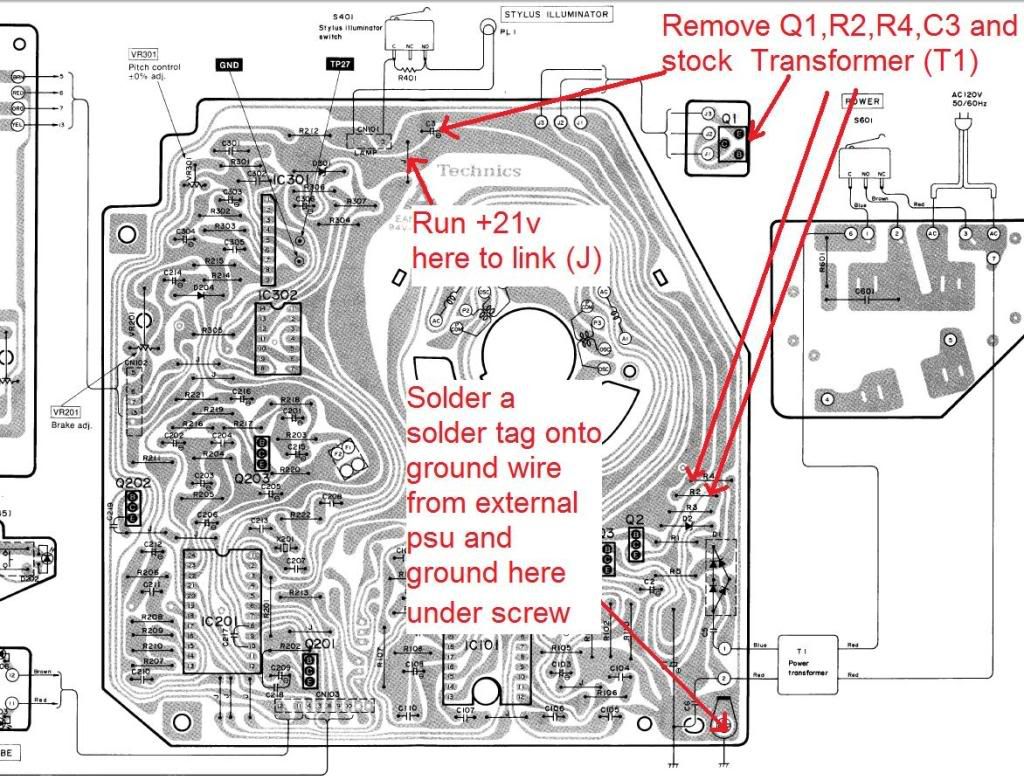INSTALLING AN EXTERNAL REGULATED DC SUPPLY IN THE TECHNICS SL-1200/1210
1. Remove the platter mat, and pull the platter upwards, using the two holes to get a firm hold. The large plastic cover must now be removed, by undoing the 5 small screws around the edge:
2. When the cover is removed, this is what you see:
The mains cable enters at the top from underneath the turntable, through a clamping gland, then it goes to the small power PCB that you can see on the left below the transformer. The first job is to remove the old mains cable:
a. Undo the small metal plate that holds the cable gland. Squeeze the underside of the cable gland using a pair of pliers, and push it upwards. The gland can be easily removed now.
b. Snip the light blue and brown AC cables from the small power PCB, just above the fuse, as seen in the picture below:
c. Release the mains cable, threading it through the bottom of the chassis. You don’t need this cable any more, unless you wish to reinstate the deck to standard fettle.
d. At this point, you can, if you wish, remove the entire mains transformer and power PCB assembly. Doing so is said to further improve sound quality. If you want to do this, carefully snip (close to the PCB) the light blue, dark blue and brown wires from the power PCB points marked “SW”. Tidy these 3 wires to one side. Then snip the small red and blue wires from the bottom left hand corner of the main control board (next to the large electrolytic capacitor). Remove the 3 small black screws from the top of the mains transformer and remove the metal screen – you can now undo the 3 securing screws holding it to the chassis. Undo the two silver screws holding the power PCB to the chassis, and then the whole assembly can be lifted away.
3. Thread your new DC power cable through the bottom of the chassis and through the small metal plate. Don’t secure it with the cable gland just yet.
4. You now need to remove the Technics 3-pin regulator device, which is located above the main control PCB, next to where the power cable enters. It has 3 wires (red, yellow, orange) which go to the main PCB (marked “J1”, “J2” and “J3”). Snip the wires as shown below:
You can leave the device in-situ, or remove it – it’s your choice.
5. Now take enough of your incoming DC cable to allow the NEGATIVE wire to thread neatly to the bottom left hand corner of the main control PCB. Attach a small circular solder tag to the end, and secure it to the main PCB earth point at the bottom left corner of the PCB, using the existing screw and serrated washer. See how the black wire in the picture below is routed to the left of the PCB, and secured:
6. Take the POSITIVE wire and shorten it, so that reaches the PCB, as shown by the white wire in the pictures above and below. Strip and tin the end, and solder it to the wire link on the PCB (just to the left of the word “LAMP”) as shown below:
7. Double-check your PSU polarity, and that it’s giving 21v DC. Test that everything’s OK by replacing the platter (don’t worry about the plastic cover for this testing). Plug your DC lead into the PSU in and turn it on. The red strobe light should be illuminated all the time, irrespective of the position of the on/off switch. Press the start/stop button and the platter should spin up and stabilise. If all is well, remove the platter, replace the plastic cover, put the platter back on again, and that’s it!
8. If you are bothered about not having a working power switch on your deck, it’s not much trouble to take the blue and brown wires that you may have snipped in Step 2d, and route your positive DC lead through the deck’s power switch, using these existing wires. You’ll have to work out which ones to use with the aid of a multimeter, but that’s not difficult! Then your deck will operate exactly as before.










 Reply With Quote
Reply With Quote Originally Posted by kininigin
Originally Posted by kininigin


